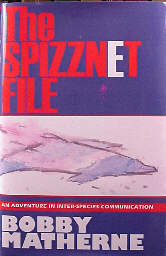![Dolphin -- Watercolor by Grandson Chris Bayhi [at 8 yrs old]](dolphin.gif)
Site Map: MAIN / SpizzNet Novel / This Page
![Dolphin -- Watercolor by Grandson Chris Bayhi [at 8 yrs old]](dolphin.gif)
Chapter 9: Dolphin Eyes
[©1997 by Bobby Matherne]
ICN returned from its commercial break and continued the broadcast with an interview with Dr. Mornay.
"Dr. Mornay, you've said that even in your first meeting with Professor Todd, that he had predicted the events that were happening today: our worldwide broadcast and the dolphins' newsreel-clips of historical events. Can you tell us about that meeting?"
"As I walked to that meeting in the university coffee shop, I was thinking about how different Jim Todd was from Richard Martin. Todd the professor was interested in how the invention might be used, while Richard the engineer was mostly concerned with how it worked."
~~~ Dr. Mornay had been looking forward to his lunch with Jim, his long-time friend and professor of history at the local university. It was Jim who had gotten him interested in Velikovsky back in the early seventies by suggesting that Mornay subscribe to Pensee' magazine. Mornay had even attended a symposium at McMaster's University in Hamilton, Ontario at which he met Velikovsky and about 300 other people from all walks of life who were there to discuss Velikovsky's catastrophe theories in earnest. He was pulled out of his thoughts abruptly by "Robert!" It was Jim.
"How are you?" Jim asked as he pulled up his chair to the table.
"Busy," he replied, "remember that dolphin paper I let you read awhile back? Well, I received funding for the research I proposed and now we're actively building the dolphin phizualization apparatus I told you about last time we had lunch. "
"Whoa, tell me again what phizualization is."
"It refers to the process the dolphins use to see by means of phonation or making high-pitched sounds that they bounce off their surroundings. Phonate-visualize, in short, phizualize. The word is necessary in order to distinguish the phizualization process from the speak-visualize process. That is the method they use to create visual pictures by means of their phonation process."
"Oh, I remember now. You call that spizualization," Jim said. "Are you getting pictures yet from your apparatus?"
"Yes," he said. He was glad that Jim was not one for small talk, "The first images we got were no better than fetal sonograms, but when we began training the back-propagation neural network, the pictures began to clarify, until now we can read an eye chart across the pool with it. We're currently marketing our PHIZZNETTM equipment to research hospitals and concentrating on the SPIZZNETTM device. At present it's pictures are still fuzzy.
"Great! I remember you talking about the use of color, anything there yet?"
"Amazingly, yes. I first thought color might be added to help differentiate certain aspects of the underwater terrain, but something unexpected happened. When we first made the eye chart for calibrating the neural network, we used raised letters on the chart so that they might be distinguished from the background by their distance from it.
"That worked well, but one day George was clowning around and lowered into the water the colored eye chart that we had used as a model for the raised one. We noted minor signal differences from the colored areas of the chart. Apparently the color of the chart affected the reflected sonic waves in some way and registered a difference. We re-trained the back-propagation net, and soon we could phizualize both the colored letters and the raised letters of the two charts. On a hunch we lowered a plastic color wheel into the tank and received slight signal differences across the color changes; by re-tuning the net we created color reproductions of the wheel on our screen.
"Wow, Technicolor, too! How fantastic! Did it work for the dolphins?" Jim exclaimed. His enthusiasm felt good to Mornay.
"Well, not right away, there was still a lot of re-training of the neural network to be done. We were not at liberty to increases the frequency outside the dolphins' range. Our goal is to be able to see as well as the dolphins can, not better. Only if they could see color, did we want that capability.
"Luckily they were able to "see" color. We re-sampled our cetacean informants (we call our dolphin subjects informants, using the same word that anthropologists use to call their human subjects when they are on field trips to foreign cultures). The Fourier analysis of their frequency spectrum showed that we could crank up the high frequency end by an order of magnitude. That helped the color resolution considerably.
This relieved us all greatly because we are so used to seeing in full color that the black and white images we had been getting from the dolphins seem very drab. The colors we now get in the eyephones are more vivid than the colors in the tank itself. We believe it approaches the intensity of colors that the dolphins experience in their minds, but of course there is no way to be sure."
"Eyephones?" Jim asked. "What's that?"
"Earphones for the eyes. It's a word that was coined from the word, earphone, which refers to a convenient device you place over ears to get information into them. Eyephones present visual information, pictures, to the eyes in an equally convenient form. Small television receivers project their images onto the retina of the eye. It's similar to the tachistoscope that eye doctors use. The result is a full color image that fills your visual field. Eyephones were first created by the virtual reality researchers who required earphone convenience for their work."
"Okay, virtual reality I know a little about. And I have had eyephones on, only I didn't know them by that name. I've been to one of those golf parlors where you can play a famous golf course in this one little room. You tee off, walk from shot to shot, actually walking on a sort of treadmill as the fairway goes floating by, swing the club, watch the ball fly, putt out, the whole nine yards, or nine holes as in this case. I felt just like I had just been over the back nine of Pinehurst No. 2. I'm going back to try Bay Hills next week."
"Yes, that's one application of virtual reality. It was my study of virtual reality technology that led me to my models of dolphin communication in the first place. But here's another unexpected discovery since I last talked to you. Dolphins can phizualize in air and in water!"
"Holy Mackerel!" Jim Todd was not given to loud outbursts, but this impacted directly on his field of study. "Color newsreel footage of history from the ears and mouths of dolphins. I hope they pass on stories from generation to generation like humans do, because if they do, we will get to see the destruction of Pompeii, the explosion of the islands of Santorini and Krakatoa, and who knows how many other catastrophes in the history of mankind. Maybe scenes before man walked the earth, since dolphins preceded homo sapiens. And the theories of Velikovsky! Eyewitnesses to history! Is it really possible? How did you find out?"
"Through the ears and the eyes of dolphins," he corrected, "that's what I want to tell you about. Something had always bothered about that whaling expedition with the harpoon guns. Remember the episode?"
"Sure. The whales saw the harpoon kill a fellow whale in one location, and shortly thereafter whales at a distant location avoided only ships with a harpoon gun."
"Right," he continued, "the part that bothered me was that the harpoon guns were in the air. The visual sight of cetaceans is too primitive for them to be able to resolve anything farther away than a couple of feet away, so the ships and harpoon guns must have been phizualized in the air and then spizualized through the water to the other location. But what is the function of their eyes if their phonation apparatus is so acute?"
"Hmmm, good question," Jim said, "any good answers yet?"
"That's what I wanted to tell you. Once we got the phizualization eyephones working, we noticed an offset of the image field that we had to correct manually. The question arose, how do the dolphins align their phizual field? We suspect that the way they do it is via their visual field, the information they receive from their eyes."
"Like we use sounds to help us locate noisy objects in our environment?"
"Exactly, and also through our hands and operating on the world. When we shoot a gun, we know immediately if the world is aligned properly."
"Robert, I'm confused. I never align objects I see. They're always where I see them."
"Fair comment. Remember the upside-down glasses experiment? If the subject was not allowed to manipulate his environment, then his inverted field would never right itself?"
"Oh yeah, that kind of alignment," Jim saw where Robert was headed, "and if I can't manipulate the environment, the sounds I hear will help me align my environment, like when I see a train coming and hear its whistle blowing."
"Right on, Jim," he enjoyed talking with Jim because he caught on very quickly, "and dolphins hardly touch their environment at all. They bruise very easily, so they mostly avoid direct contact except with food and friends.
"So their visual channel of information provides them with the orientation their phizualization needs to line up their 3-D constructions in their heads with the actual world. We added visual inputs and fed them into the phizualization network and eliminated the need for manual correction of the offset -- the eyephones' image now lines up automatically with the real world.
"The defense department is interested in using our phizualization technique for night vision. They want it to work in absolute darkness, so I suggested that they use radio signals to provide alignment signals. We suspect that light is only one of the means dolphins use for alignment with the real world. They also use gravity like we do, but also ocean currents, smells, and other signals that we don't yet know about.
"This allows them to navigate in the darkest spaces without getting lost. During our testing, we commonly turn off all the lights in the lab except one small calibration light, and the person in the eyephones does not know the difference. To dolphins it's always daylight"
[End of Dolphin Eyes, Chapter 9. To Read Next Chapter Click Book Jacket at Right:]


Are you unhappy with your life? Fearful? Angry? Anxious? Feel down or upset by everyday occurrences? Plagued by chronic discomforts like migraines or tension-type headaches? At Last! An Alternative Approach to Removing Unwanted Physical Body States without Drugs or Psychotherapy!Click on Faces Below.

